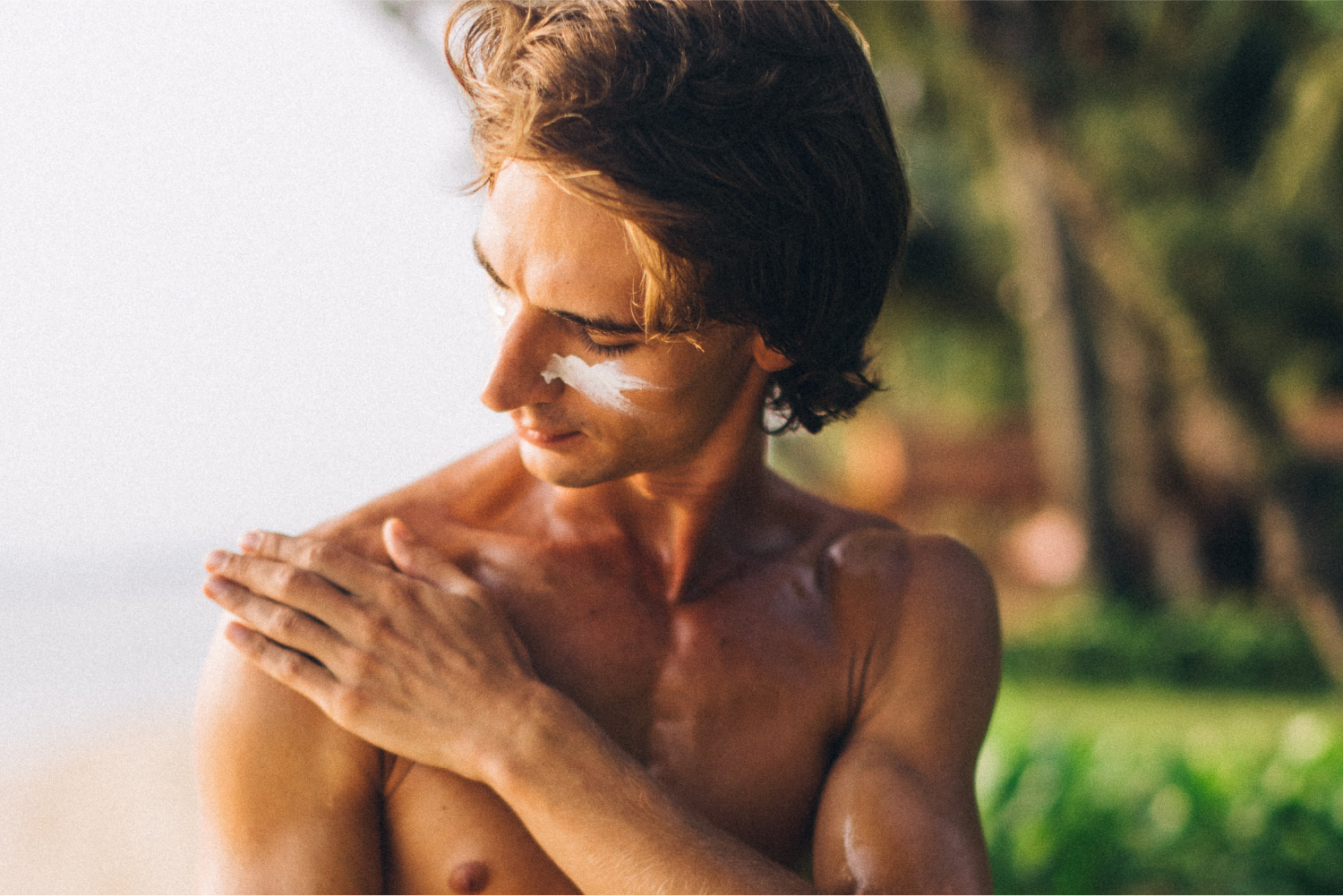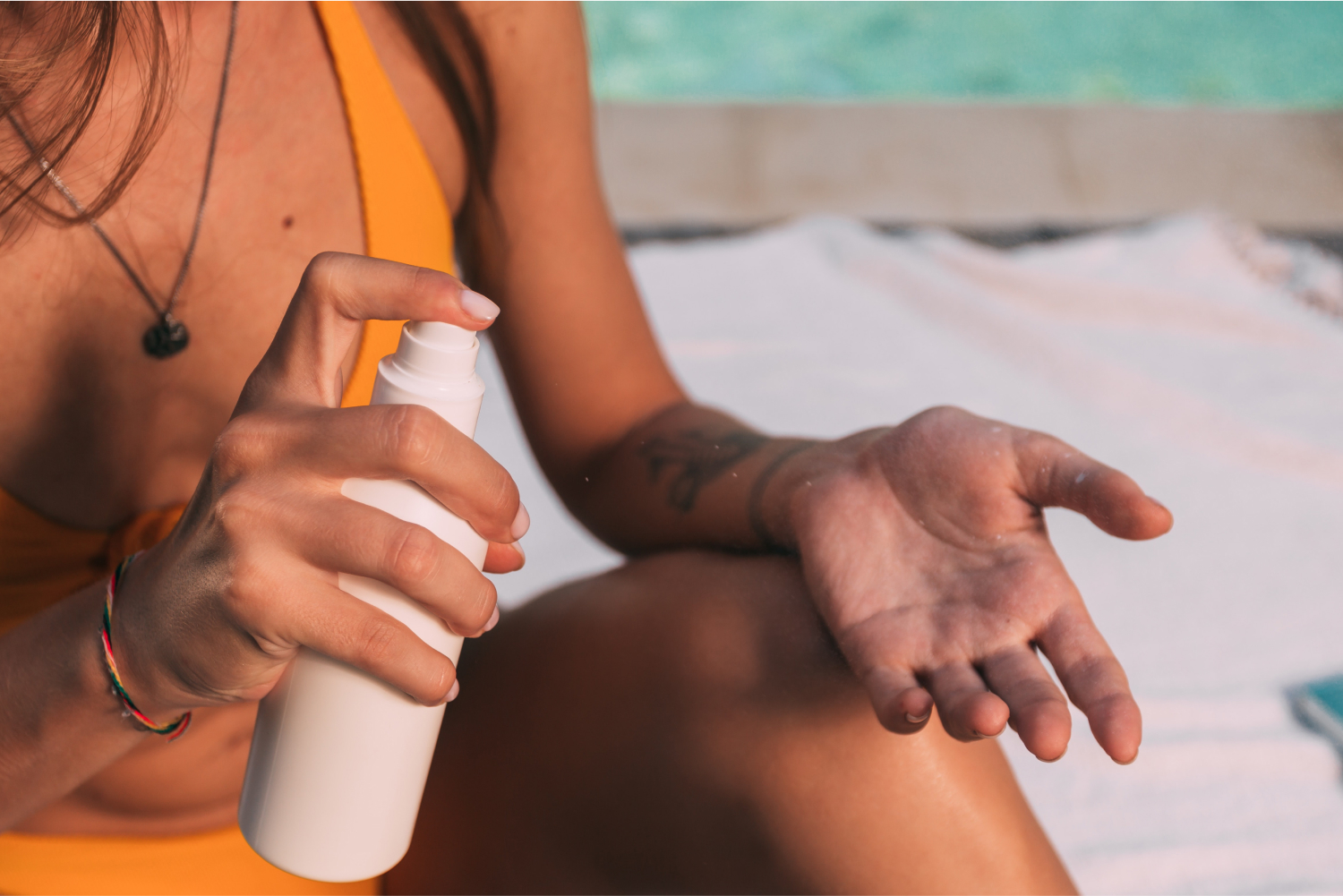
By now you already know that most dermatologists recommend that you use sunscreen daily, even if it’s raining or in the winter. This is especially important if you live in hot climates and are subjected to high amounts of sun exposure. However, it may be hard for you to understand what your skin needs and what may be the best suitor for your skin. It’s very hard to know how to choose sunscreen. Therefore, we have gathered the most common questions regarding sunscreens and have answered them all in just one place, giving you a huge sunscreen FAQ sheet you can read any time you have any doubts.
On this post:
- Sunscreen Basics
- What exactly is sunscreen?
- How does sunscreen work?
- What does SPF mean?
- What does broad-spectrum mean?
- How to know UVA protection?
- Mineral vs Chemical Sunscreen (or, Inorganic vs Organic)
- Sunscreen Safety
- Is sunscreen safe?
- Are “natural sunscreens” better?
- Which sunscreen ingredients should you avoid in your SPF?
- When to Wear Sunscreen
- Facial Sunscreen
- Do you need a specific sunscreen for your face?
- What kind of texture should I look for in sunscreen?
- Tinted vs untinted face sunscreen
- How to choose the best face sunscreen for you
- Can sunscreen replace your moisturizer?
- How much sunscreen should you use on your face?
- Can You Use Sunscreen if You…?
Sunscreen Basics
Before we start talking about sunscreens as products, let’s talk a little bit about how sunscreens work. Here are the basics of what you need to know about sun protection.
What exactly is sunscreen?
Sunscreen is a cosmetic product that help to protect your skin against the harm of sun radiation. Sunscreens are not only perfect for protecting the skin from burning and help to prevent cancer, but they are also the best anti-aging product.
Sun radiation can induce many changes in your skin. Firstly, it can burn your skin–that is the most evident one. However, there are a few effects that will only be seen in the long run. We also have melanoma and other skin cancers that are induced by sun radiation altering cells. Additionally, it will also disrupt the proteins that are in the base of the structure of the dermis, the medium layer of the skin. This means that by losing collagen and elastin fibers, the skin gains more wrinkles and loses firmness.
How does sunscreen work?
Sunscreens work by deflecting and/or absorbing radiation and turning it into heat. This means that a considerable part of the radiation will not hit your cells, reducing the effects it would cause–be it burns, premature aging, or skin cancer.
Sunscreens contain ingredients that are able to deal with solar radiation in two ways. Some ingredients can either deflect radiation or absorb it; some can do both. Traditionally, there was this notion that inorganic (or “mineral”) sunscreens deflect radiation, and organic (or “chemical”) sunscreens absorb it. In fact, that’s not true. Recent studies have shown that all sunscreen ingredients work the same way. There is a slight difference of about 5% between mineral and chemical sunscreen ingredients when it comes to deflecting radiation, but that difference isn’t dramatic enough to make you choose one or the other.
Indeed, both methods are incredibly important in fighting radiation. In short, why is this important? Because sun radiation reaches the cell DNA and leads to mutations. Consequently, these can lead to skin cancer, as your skin is now producing mutated cells due to the damage the radiation has induced. Actually, the skin already has one widely known mechanism to defend itself: melanin production. In short, tanning. When radiation hits the DNA, the skin starts producing melanin to protect the cell DNA. However, this is not enough, as the melanin is only produced after the radiation has started hitting the DNA and therefore it can be too late. Sunscreens prevent radiation from even reaching the cell DNA and therefore help to prevent skin cancer. Additionally, they also prevent sunburns and dark spots due to the same properties.
What does SPF mean?
SPF is a measure of UVB radiation protection. UVB radiation is the type of radiation responsible for burning your skin.
Here’s what some common SPF values mean:
- SPF15 – absorbs or reflects 93% of UVB radiation
- SPF30 – absorbs or reflects 97% of UVB radiation
- SPF50 and SPF50+ – absorbs or reflects 98% of UVB radiation
You may be thinking that SPF50 does not look like a huge improvement over SPF30. However, think about it like this: imagine one single ray of sunshine. Imagine that this single ray contains 100 photons, or light particles). SPF30 will prevent 97 of those photons from reaching your skin; 3 will make it through. Conversely, SPF50 will prevent 98 of those photons from reaching your skin, and only 2 will make it through. Multiply this by the millions and millions of photons that you’re exposed to, every single day, and you will quickly realize that 97% and 98% are actually very different levels of protection.
What about SPF100, you may be asking? Does that exist? Well, yes, it does exist, but in Europe, where we are located, brands are not legally allowed to state more than SPF50 on the packaging. In Europe, anything above SPF50 will be labeled SPF50+.
What does broad-spectrum mean?
Very simply, a “broad-spectrum” sunscreen is a sunscreen that protects against both UVB and UVA radiation. Broad-spectrum sunscreen is (fortunately) becoming the norm, so you won’t have to search far and wide for a product that protects you from both UVB and UVA rays. Most will simply claim to be “broad-spectrum” on the label, and you can trust that information to be accurate.
In addition, many brands are already formulating sunscreens that also protect from infrared and visible light (particularly blue light).
How to know UVA protection?
If “broad-spectrum” isn’t enough for you, and you’re like to know the level of UVA protection that a sunscreen offers (just like you know the level of UVB protection through the SPF rating), there are two ratings to keep an eye out for.

The Japanese system uses the letters “PA” followed by plus signs to indicate how much UVA protection a product offers. You should be looking for products rated PA+++, high UVA protection, or PA++++, extremely high UVA protection.
The European Union uses an alternate system: according to EU recommendations, the UVA protection for each sunscreen should be at least a third of the labeled SPF. (That means that a product with a SPF of 30 should have a UVA protection rating, or PPD, of 10.) A product that achieves this requirement will be labeled with a UVA logo that features the letters “UVA” printed in a circle.
Mineral vs Chemical Sunscreen (or, Inorganic vs Organic)
Let’s begin with a quick disclaimer. Mineral sunscreens are also called inorganic or physical sunscreens. On the other hand, chemical sunscreens are also called organic sunscreens.
We’ll be using “mineral” and “chemical” in this section, but keep in mind that every kind of cosmetic is technically a chemical (as it relates to chemistry as a science). So, what’s the actual difference between mineral and chemical sunscreens?
Mineral sunscreens are those that only contain zinc oxide and titanium dioxide as sun filters. That’s it. Just those two. Chemical sunscreens are… all of the others.
Even though previously we thought that mineral sunscreens deflected radiation and chemical sunscreens absorbed them, it is not exactly true. New findings have discovered that mineral sunscreens also absorb radiation and turn it into heat. So this means that both mineral sunscreens and chemical ones will both deflect and absorb radiation.
That being said, mineral sunscreens still deflect more than chemical ones, creating what is known as a “white cast”. What’s a white cast, exactly? It’s that whitish/grayish finish you get on your skin after applying sunscreens that contain zinc oxide and titanium dioxide. Because these compounds are white and deflect a lot of light, you end up looking a little reflective yourself. This issue can be improved by using the micro or nano versions of zinc oxide and titanium dioxide–however, it’s not easy to find mineral sunscreens that fully avoid the dreaded white cast. (Which is, as you may imagine, particularly problematic on dark skin, as it’s way more noticeable.)

Sunscreen Safety
If you are going to apply a product to your skin, it is understandable that you have concerns about its safety. In this section, we’ll explain everything you need to know about sunscreen safety.
Is sunscreen safe?
In short: yes, sunscreen is safe. Don’t let scaremongers mislead you into thinking it’s not.
A lot of fears about sunscreens come from the supposed “dangers” of chemical sunscreens. Even though, in the 90s, some chemical sunscreens used to cause skin intolerance, those aren’t widely used anymore. In Europe, they have been phased out completely. The chemical filters we now have are much better. Not only they’re milder on sensitive skins, but they also protect from a broad radiation spectrum.
This may come as a surprise to some people, but the fact is that different countries have access to different sunscreen ingredients, or filters. In the USA, for example, sunscreens are considered a medication, and no new sunscreen ingredients have been introduced since the 90s. We’ve dedicated a whole article to the differences between European and American sunscreens, if you’d like to read up on that. In short: if you’ve ever read about “chemical” sunscreens being worse for sensitive skins, just ditch the American formulas. One way to solve this is turning to the European (we sell them), Asian or Australian ones.
Of course, there will always be some people whose skin will not tolerate anything but mineral sunscreens, but the percentage is extremely low.
Are “natural sunscreens” better?
One common misconception is that chemical sunscreens are dangerous because they are “chemical”, and mineral sunscreens are better because they are natural. This isn’t true at all.
Even though mineral sun filters (zinc oxide and titanium dioxide) come from natural sources, they have to endure several purifying processes in order to be safe for use. This is due to the fact that, in the wild, they contain impurities that are toxic to humans. Hence, they never actually reach your bottle of sunscreen in that “natural” presentation. There are no “natural” sunscreens!
This isn’t a bad thing: your body is unable to tell if something is natural or not. The body only cares about molecules, and those don’t come with “Made in” information. Additionally, nature itself makes some of the most potent toxins, so keep in mind that natural does not mean safer.
Which sunscreen ingredients should you avoid in your SPF?
Lots of people find themselves scanning long lists of ingredients looking for dangerous ingredients they should avoid.
The truth is that, except in cases where you have known allergies, there are no ingredients that you should ban. If you have particularly sensitive skin, we advise you to look for fragrance-free options, but those with fragrance can still be compatible with skin sensitivity. Regarding sunscreen filters, the ones used in the EU are the latest-generation ones and as far as science knows, are safe. All ingredients that are known to cause harm to humans are removed from formulas, so you don’t need to be browsing all INCI lists searching for a “safe” formula. All of the ones we carry on our website are compatible with the current legislation, which takes into account scientific evidence.
Just keep in mind that if you know you don’t get along with a certain ingredient, maybe try to avoid it. However, if it’s not an allergy, but a certain degree of intolerance, the formula can prevent that from happening. Keep in mind to avoid anything you’re allergic to, but know that other ingredients might disrupt your skin within one certain formula, but might be just fine in another one. Formula is queen.

When to Wear Sunscreen
To put it simply, you should wear sunscreen before sun exposure. That’s clear enough, right? The trouble is figuring out what counts as sun exposure (what if it’s cloudy? what if it’s raining?), and how often you should be reapplying your sunscreen in order to maximize your level of sun protection. In this section, we’re clearing up all misconceptions regarding the “when” of sunscreen application.
Should you wear sunscreen everyday?
Most dermatologists recommend that you use sunscreen daily. Even if it’s raining? Yes. Even if it’s winter? Yes. This is especially important if you live in hot climates and are subjected to high amounts of sun exposure (for example, Australia used to have an ozone layer hole that let pass much more radiation). As for wearing sunscreen indoors, we’ve dedicated a whole article to this debate. Here are some things to take into consideration:
- How big are your windows?
- Are you close to those windows, throughout the day?
- How is the weather outside? What is the UV index currently?
- What is the color of your walls? Does it reflect a lot of light?
- If you work indoors, how much time do you actually plan to spend outside? Are you walking to work? Having lunch outside? Going for a smoke break with your co-workers?
When should you reapply sunscreen?
As a general rule, you should reapply sunscreen:
- After swimming or heavily sweating;
- Right after towel-drying the skin;
- After 2h of intense sun exposure;
- After half a day of light sun exposure.
Facial Sunscreen
A few years ago, sunscreen was mainly used on the body, during beach or pool holidays; however, more and more people are using sunscreen on their face every day these days. In this section, we’re discussing the specifics of facial sunscreen, and helping you pick the right option for your needs.
Do you need a specific sunscreen for your face?
The short answer is that you probably do.
Body sunscreen can be used on the face, however, there are some issues we need to address. The first is that the texture will probably not be great for the face. This is true especially if you suffer from oily or combination skin, as no body sunscreen will be mattifying. Additionally, there is the issue with the eye contour, as most body sunscreens will cause you intense burning if they get into the eyes. Unfortunately, this can happen by just sweating and the sweat with sunscreen going into your eyes. Lastly, they are not made to be used together with other products, so you can experience more pilling when trying to apply with your regular skincare routine or make-up. However, if you’ve found a body sunscreen that you love to use on your face, that is totally ok.
What kind of texture should I look for in sunscreen?
We usually recommend that you go for a cream or an emulsion/lotion/gel cream. Usually, people with oily skin tend to prefer lighter versions, such as oil-free emulsions or gels. If you have dry skin, you will probably prefer heavier formulas such as creams, that nourish your skin for longer. You can even check out our selection of sunscreens for oily skin in order to find a great one if you suffer from oily skin.
Texture isn’t only important to match your skin type, though: it’s also important because it’s going to help achieve your desired level of protection.
Fluid textures are easily spreadable and that is not necessarily a good thing in sunscreens. More spreadability means you will need less product to cover the entire surface of the skin. Which, in turn, means that you’ll use less sunscreen than you should. One other issue is related to pigmented and powder products. You will never apply the right amount of sunscreen because you’d look like a Madame Tussaud’s figurine–or Marie Antoinette, all covered in powder! Additionally, spray sunscreens are great but save them for reapplying your sunscreen throughout the day.
In short: if you want to achieve the highest possible level of protection, consider following these tips:
- Choose the highest SPF available;
- Choose a non-tinted formula;
- Definitely make sure you’re not applying a powder SPF unless you wish to cake your face;
- Make sure you apply around half a teaspoon of sunscreen to your face (average, apply more if you have a large face, if you’re bald, etc.);
- Alternatively, if you’re using a very fluid sunscreen, consider applying sunscreen twice instead of just one time to make sure you use more;
- You don’t need to rub stick formulas applied locally, but always spread sunscreen sprays even if they tell you you don’t need to. The fact is, you will probably not reach every inch of the face if you’re spraying.
Tinted vs untinted face sunscreen
Some formulas have tinted options, so if you’re looking for a bit of color correction, this option might help you combine two products in one. However, keep in mind that tinted sunscreens might make you use less of them due to wanting to have light coverage. Always keep in mind that the amount of product should always be around 1 teaspoon for the face, neck, and head. In spite of this recommendation, what you should always keep in mind is that you should properly cover the entirety of your skin, and that varies with several factors such as if you have a beard and how large your face is.
How to choose the best face sunscreen for you
There are some key points that you should consider when purchasing a face sunscreen. We’ve listed them by top priority to low priority, so you can keep in mind what is most important.
- SPF
- UVA protection
- Your skin type (as this may influence your choice of texture)
- Any extra features (such as eye-compatible technology, anti-dark spots action, extra antioxidant benefits, etc)
- Tinted or non-tinted formula
You may also want to consider these questions:
- Can you afford to use a lot of your chosen sunscreen? The last thing you want is to use very little because you’re trying to save it;
- Am you reaching for the highest SPF available? If not… why not?
- Do you like your chosen texture? Is it too rich for you? Is it too dry? Could you find an alternative?
- How important is the white cast issue? (If you have a darker skin tone, it’s likely to be super important.)
Can sunscreen replace your moisturizer?
It depends on your skin, but if you choose your sunscreen wisely and according to your needs, you most certainly can.
How much sunscreen should you use on your face?
If we’re going all sciencey here, you should use 2mg/cm². This is how sunscreens are tested and it’s the only way you’re achieving the SPF stated on the bottle. The thing is, 2mg/cm2 is A LOT of sunscreen and you will only reach the stated level of protection if you actually use that amount. This is why it’s so important to use the highest sunscreen available–you will hardly be reaching that amount of protection when actually using it.
What does 2mg/cm² actually mean regarding the amount of product you should use? It will always depend on the exposed area of your face, ears, neck and bust. But considering a medium-sized face, neck and bust, it should be around half a teaspoon. Again, if you know that you have a large face, or your forehead stretches longer, or you use short hair, keep in mind to cover everything in sunscreen. Never, ever, forget the ears.
Can You Use Sunscreen if You…?
Sometimes, there is the idea that not all skin types can use sunscreen: oily skin will only get greasier, dry skin will only get drier, and so on. This becomes even more complicated when there are skin conditions involved, such as melasma, acne, or rosacea. In this section, we’re going to clear this all up: who can use sunscreen, and who should avoid using sunscreen? (Spoiler: all skin types, with or without associated skin conditions, can and should use sunscreen.)
Tend to have dark spots, hyperpigmentation, or melasma?
Of course! Always choose the highest protection available and try to keep out of the sun. Even though previously people tented to recommend mineral sunscreens, it is no longer the case. Given that scientists discovered that mineral sunscreens also absorb radiation and convert it into heat, it no longer matters. What matters, is to achieve the broadest protection possible, and you can do that by using more filters. We suggest you browse our selection of sunscreen for dark spots if you’re having trouble finding a good one.
Have oily or acne-prone skin?
Yep! Oily and acne-prone needs as much protection as any other skin type. Make sure to look for sunscreens with lightweight formulas. If you like, you can also choose products with mattifying and oil-regulating properties. Here are some of our favorite sunscreens for oily skin.
Have rosacea?
Yes, you can use sunscreen if you have rosacea. Choose a product that is fragrance and alcohol-free, as these ingredients may induce rosacea flares in people with this condition.
Are pregnant?
Yes, you can use sunscreen if you’re pregnant. The only thing you should avoid is sunscreens that state they’re to depigment the skin. Other than that, you’re free to use whatever you like best. Again, the important part here is to wear something that you’re comfortable with. Given that pregnancy tends to increase the risk for dark spots, prevention is key.
Well, wasn’t that a handful of information! Now that we’ve shared the absolute basics of what you need to know about sunscreen, we hope you’re a little more convinced of the importance of wearing sunscreen every day, and a little more knowledgeable about how to wear your sunscreen so that it works as best as it can. If you’d still like to know more, you’re in luck: we’re sunscreen fanatics, here at Care to Beauty, and we’ve got plenty more articles about sunscreen. Read up, and be safe in the sun!
Pharmacy Technician & Beauty Writer


